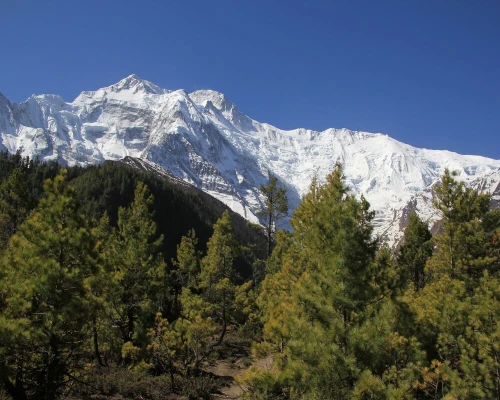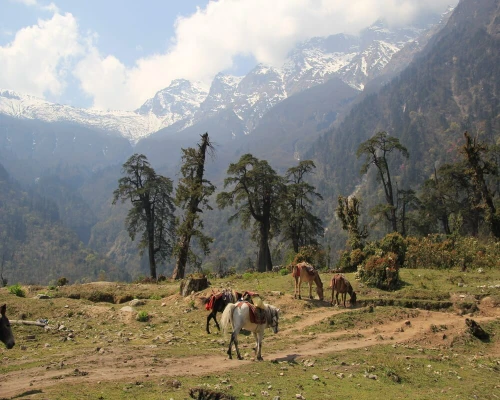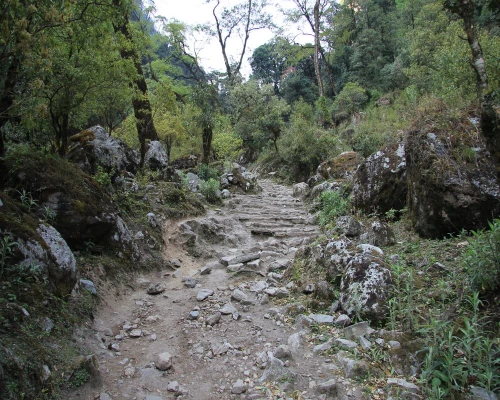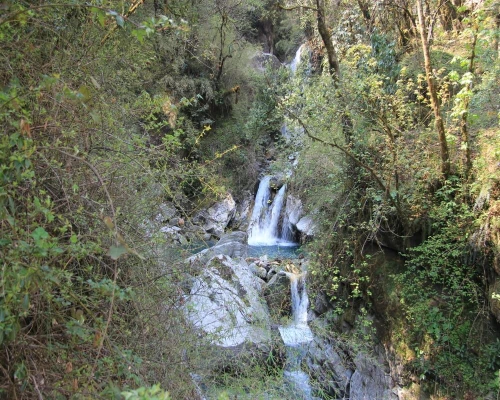Mardi Himal Trek in Nepal has quickly become a trending and popular trekking destination. This trek allows you to leave your footprints at the upper viewpoint of a mountain and immerse yourself in the beauty of the green lush forest. It offers an enchanting and virgin experience along Nepal's new trekking route. Among the numerous trekking routes in Nepal, the Mardi Himal trail stands out as one of the best and most pristine options. One of its appealing features is that it is still less crowded and offers a tranquil environment for trekkers. Located on the outskirts of the Annapurna Base Camp Trekking route, the Mardi Himal trail treats trekkers to breathtaking mountain scenery.
The trail provides captivating views of the surrounding mountains, including the awe-inspiring Annapurna and Machhapuchhre (Fishtail) peaks. These majestic mountains offer a spectacular backdrop throughout the trek. Additionally, the Mardi Himal route takes trekkers through magnificent forest environments. Walking amidst the green lush forests, you can experience the serenity and beauty of the natural surroundings.
Overall, the Mardi Himal Trek offers a glorious walking holiday in Nepal, allowing you to enjoy the pristine beauty of the trail. It is a less-crowded route, providing a sense of tranquility and an opportunity to explore untouched natural landscapes. With its combination of mountain vistas and lush forests, this trek has become a hot destination for those seeking a captivating and unique trekking experience in Nepal.
Enjoy the magical companyof majestic peaks like the Machhapuchhare, Himchuli and Annapurna South while feeling the breezy freshness of mountain air on your way to the top of 4500 meters of an elevation
- The best view of Mt. Machhapuchhre, also known as Fishtail Mountain, can be enjoyed from the village of Ghorepani in the Annapurna region of Nepal. Ghorepani is located at an altitude of around 2,800 meters (9,186 feet) and offers a stunning panoramic view of the majestic Machhapuchhre peak.
- In addition to the breathtaking view of the mountain, Ghorepani is surrounded by green lush diverse forests, which add to the natural beauty of the area. These forests are home to a wide range of flora and fauna, making it a great destination for nature lovers and wildlife enthusiasts. You can expect to encounter various species of birds, butterflies, and even some wildlife, such as deer and monkeys, during your trek.
- Ghorepani is also known for its vibrant Gurung culture. The local Gurung community has a rich heritage and their warm hospitality allows visitors to immerse themselves in their unique traditions and customs. You can learn about their lifestyle, taste local cuisine, and even participate in cultural activities, making it a rewarding cultural experience.
- One of the highlights of Ghorepani is the serenity and tranquility it offers. The village is situated away from the hustle and bustle of city life, providing a peaceful atmosphere that allows visitors to relax and rejuvenate amidst the beauty of nature. The tranquil environment, combined with the magnificent mountain views, creates a sense of awe and wonder.
- Ghorepani is also renowned for its vantage point, Poon Hill. Located just above the village, Poon Hill is a popular viewpoint that offers a panoramic view of over a dozen mountain vistas, including Mt. Machhapuchhre, Annapurna, and Dhaulagiri ranges. This viewpoint is especially famous for its breathtaking sunrise and sunset views, making it a photographer's paradise.
- If you have limited time, it is possible to do a trek to Ghorepani and Poon Hill in less than a week. Typically, treks to this area can range from 3 to 7 days, depending on the route and pace you choose. A common itinerary includes starting the trek from Nayapul, passing through Tikhedhunga and Ghorepani, and culminating with the sunrise view from Poon Hill. However, it's important to note that the duration of the trek can vary depending on your fitness level and preferences.
- Overall, Ghorepani and Poon Hill offer a perfect blend of natural beauty, cultural immersion, and serene tranquility. It's a destination that satisfies both adventure seekers and nature lovers, providing an unforgettable experience for anyone who visits.
Mardi Himal Trek offers
Mardi Himal Trek offers a range of awe-inspiring experiences. In just 7 days, you'll witness the spectacular sight of mountains like Annapurna South, Machhapuchhre, and Himchuli. The trek takes you to the Mardi Himal Base Camp, where you can enjoy breathtaking views of the Annapurna range. Along the way, you'll encounter beautiful homestays, encounter helpful locals, and traverse diverse and dense forests. This trek showcases stunning landscape hills, mixed local culture, pristine mountain views, and spectacular valleys. It takes you off the beaten path of the Annapurna region, offering a unique and rewarding experience. From Kathmandu to Pokhara, you'll be greeted with warm hospitality and have the chance to appreciate mountain landscapes and local delicacies. As you ascend, you'll feel the mountains drawing you closer, and you'll be amazed by the rich biodiversity and wildlife. With Nepal Nomad as your guide, you can trust in their expertise to ensure a perfect adventure. They can even tailor a Mardi Himal Trek itinerary to suit your preferences.
Nepal Nomad is dedicated to providing a perfect adventure for trekkers, climbers, and adventurers worldwide. With their expertise and knowledge, you can trust them to address any doubts or questions you may have about the Mardi Himal Trek. Whether you're looking for guidance, information, or a tailored itinerary, Nepal Nomad is ready to assist you in creating an unforgettable experience. Feel free to contact them to discuss your trekking plans and explore the possibilities of a customized Mardi Himal Trek Itinerary that suits your preferences and requirements.
Moderate level of difficulty
Mardi Trek is a trekking route in Nepal that presents a moderate level of difficulty. It is important to be cautious of the narrow valleys and high ridges along the trail. The initial part of the trek is entirely uphill until you reach Upper View Point, which can make it challenging for some people. However, when compared to high-altitude destinations in Nepal, the Mardi Trek is considered relatively easier.
For individuals who are physically fit and have prior trekking experience, this trail should not be too difficult. However, it is crucial to note that during the snow season, the trail can become more treacherous and tricky. In such conditions, it is essential for trekkers to carefully follow the instructions of a guide or a local expert. The presence of numerous crevasses can make navigation on the trail difficult and confusing.
The season for Mardi Himal Journey
The best seasons for embarking on the Mardi Himal journey in Nepal are spring and autumn. These seasons are considered the peak trekking seasons in the country.
Spring, which falls between the months of March and May, offers pleasant weather and clear skies. The temperatures are moderate, and the surrounding landscapes are adorned with blooming flowers and lush greenery. This season provides excellent visibility, allowing trekkers to enjoy breathtaking views of the Himalayan peaks and the surrounding natural beauty.
Autumn, spanning from September to November, is another ideal time for the Mardi Himal journey. During this season, the weather is generally stable, with mild temperatures during the day and cool evenings. The skies are clear, providing unobstructed views of the mountains. The autumn season is also known for its vibrant foliage, as the forests and hillsides are adorned with colorful autumnal hues.
On the other hand, the monsoon season (June to August) is not recommended for trekking the Mardi Himal trail. The heavy rainfall leads to muddy trails, leeches, and a generally gloomy atmosphere, making the trekking experience less enjoyable.
Similarly, winter (December to February) brings cold temperatures and slippery conditions on the trail. While the snowy landscapes can be visually stunning, the risk of avalanches and difficult terrain can make the journey more dangerous and challenging.
To fully appreciate the beauty of the Mardi Himal trek and ensure a safer and more comfortable experience, it is advisable to plan your journey during the spring or autumn seasons.
The Mardi Himal Trek is an ideal choice for you
The Mardi Himal Trek offers a unique and captivating experience for those seeking to immerse themselves in the awe-inspiring beauty of the Annapurna region in Nepal. If you have ever dreamt of enjoying the grandeur of the Annapurnas without the hustle and bustle of crowded trails, then the Mardi Himal Trek is an ideal choice for you.
This trek will take you on a journey through stunning landscapes, allowing you to witness snow-capped mountains, verdant forests drenched in tropical rainfall, and charming villages inhabited by warm and welcoming locals. The itinerary has been carefully crafted to provide you with the best possible experience, ensuring a suitable pace and acclimatization schedule to minimize any altitude-related challenges.
With the guidance of expert trekking guides, you can rest assured that each member of your trekking party will be well taken care of. The guides will ensure that everyone has a fantastic time exploring the picturesque green hills and the majestic White Mountains that make this region so special.
If you yearn for an adventure in a serene and less crowded setting, surrounded by breathtaking natural wonders and the hospitality of the local communities, then the Mardi Himal Trek is indeed the right choice for you.






